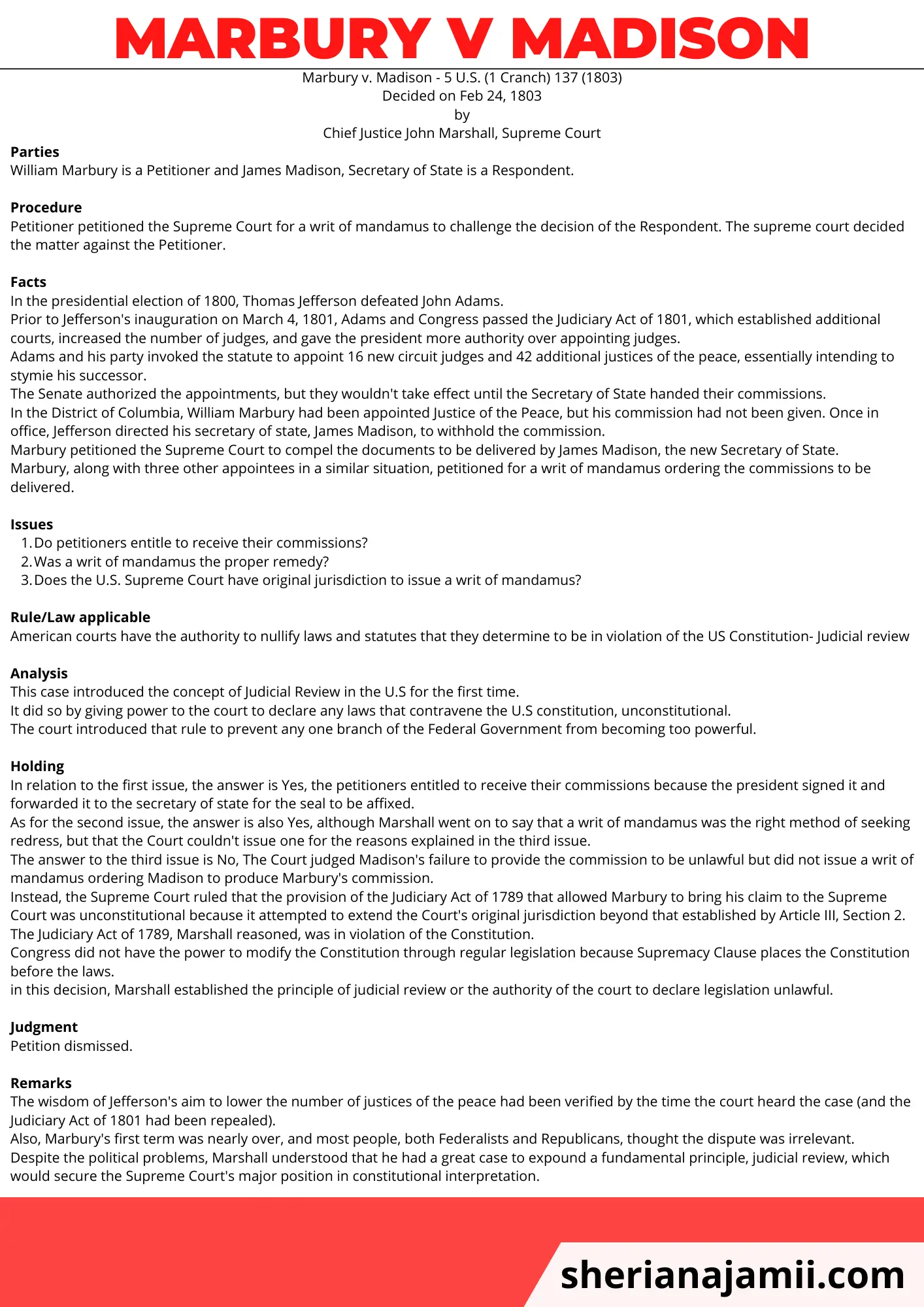Here you will see Marbury versus Madison case brief/summary.
Marbury v Madison is an old U.S landmark case that introduced the concept of Judicial review in the U.S legal system in 1803.
Also through the Marbury v Madison case for the first time, federal courts were given the authority to overturn a congress act on the grounds that it was unconstitutional.
Here I will provide you with the Marbury versus Madison case brief just to enable you to understand everything you need to know about Marbury versus Madison case in a simple and accurate way.
Interested in learning how to write your own case brief? learn here.
Transform Your Communication, Elevate Your Career!
Ready to take your professional communication skills to new heights? Dive into the world of persuasive business correspondence with my latest book, “From Pen to Profit: The Ultimate Guide to Crafting Persuasive Business Correspondence.”

What You’ll Gain:
let’s get started
Jump to section
Marbury versus Madison case brief
The following is a simple summary of the Marbury versus Madison case brief
Marbury v. Madison – 5 U.S. (1 Cranch) 137 (1803)
Decided on Feb 24, 1803
by
Chief Justice John Marshall, Supreme Court
Parties
William Marbury is a Petitioner and James Madison, Secretary of State is a Respondent.
Procedural History
Petitioner petitioned the Supreme Court for a writ of mandamus to challenge the decision of the Respondent. The supreme court decided the matter against the Petitioner.
Facts
In the presidential election of 1800, Thomas Jefferson defeated John Adams.
Prior to Jefferson’s inauguration on March 4, 1801, Adams and Congress passed the Judiciary Act of 1801, which established additional courts, increased the number of judges, and gave the president more authority over appointing judges.
Adams and his party invoked the statute to appoint 16 new circuit judges and 42 additional justices of the peace, essentially intending to stymie his successor.
The Senate authorized the appointments, but they wouldn’t take effect until the Secretary of State handed their commissions.
In the District of Columbia, William Marbury had been appointed Justice of the Peace, but his commission had not been given. Once in office, Jefferson directed his secretary of state, James Madison, to withhold the commission.
Marbury petitioned the Supreme Court to compel the documents to be delivered by James Madison, the new Secretary of State.
Marbury, along with three other appointees in a similar situation, petitioned for a writ of mandamus ordering the commissions to be delivered.
Issues
- Do petitioners entitle to receive their commissions?
- Was a writ of mandamus the proper remedy?
- Does the U.S. Supreme Court have original jurisdiction to issue a writ of mandamus?
Rule/Law applicable
American courts have the authority to nullify laws and statutes that they determine to be in violation of the US Constitution- Judicial review
See also: what is the constitution and why do we need it?
Analysis
This case introduced the concept of Judicial Review in the U.S for the first time.
It did so by giving power to the court to declare any laws that contravene the U.S constitution, unconstitutional.
The court introduced that rule to prevent any one branch of the Federal Government from becoming too powerful.
See also: classification of the constitution in the world
Holding
In relation to the first issue, the answer is Yes, the petitioners entitled to receive their commissions because the president signed it and forwarded it to the secretary of state for the seal to be affixed.
As for the second issue, the answer is also Yes, although Marshall went on to say that a writ of mandamus was the right method of seeking redress, but that the Court couldn’t issue one for the reasons explained in the third issue.
The answer to the third issue is No, The Court judged Madison’s failure to provide the commission to be unlawful but did not issue a writ of mandamus ordering Madison to produce Marbury’s commission.
Instead, the Supreme Court ruled that the provision of the Judiciary Act of 1789 that allowed Marbury to bring his claim to the Supreme Court was unconstitutional because it attempted to extend the Court’s original jurisdiction beyond that established by Article III, Section 2.
The Judiciary Act of 1789, Marshall reasoned, was in violation of the Constitution.
Congress did not have the power to modify the Constitution through regular legislation because Supremacy Clause places the Constitution before the laws.
in this decision, Marshall established the principle of judicial review or the authority of the court to declare legislation unlawful.
Judgment
Petition dismissed.
Remarks
(this does not form part of to Marbury versus Madison case brief but it is worth noting)
The wisdom of Jefferson’s aim to lower the number of justices of the peace had been verified by the time the court heard the case (and the Judiciary Act of 1801 had been repealed).
Also, Marbury’s first term was nearly over, and most people, both Federalists and Republicans, thought the dispute was irrelevant.
Despite the political problems, Marshall understood that he had a great case to expound a fundamental principle, judicial review, which would secure the Supreme Court’s major position in constitutional interpretation.
Read the full judgment here
Other case briefs to read
Apart from Marbury versus Madison case brief, I’m sure you need to read the following
- Hamer v Sidway case brief
- Lucy v Zehmer case brief
- Pennoyer v Neff case brief
- Pierson v Post case brief
- Hawkins v Mcgee case brief
- Tinker v des Moines case brief
- Hadley v Baxendale case brief
- Duncan v Louisiana case brief
- Garrett v Dailey case brief
- Brown v Board of education case brief
- Griswold v Connecticut case brief
- Katz v United States case brief
- Riley v California case brief | United States v. Wurie
- Leonard v Pepsico case brief
- Wickard v Filburn case brief
- District of Columbia v. Heller case brief
- Gonzales v Raich case brief
- Shelley v Kraemer case brief
- Tennessee v Garner case brief




